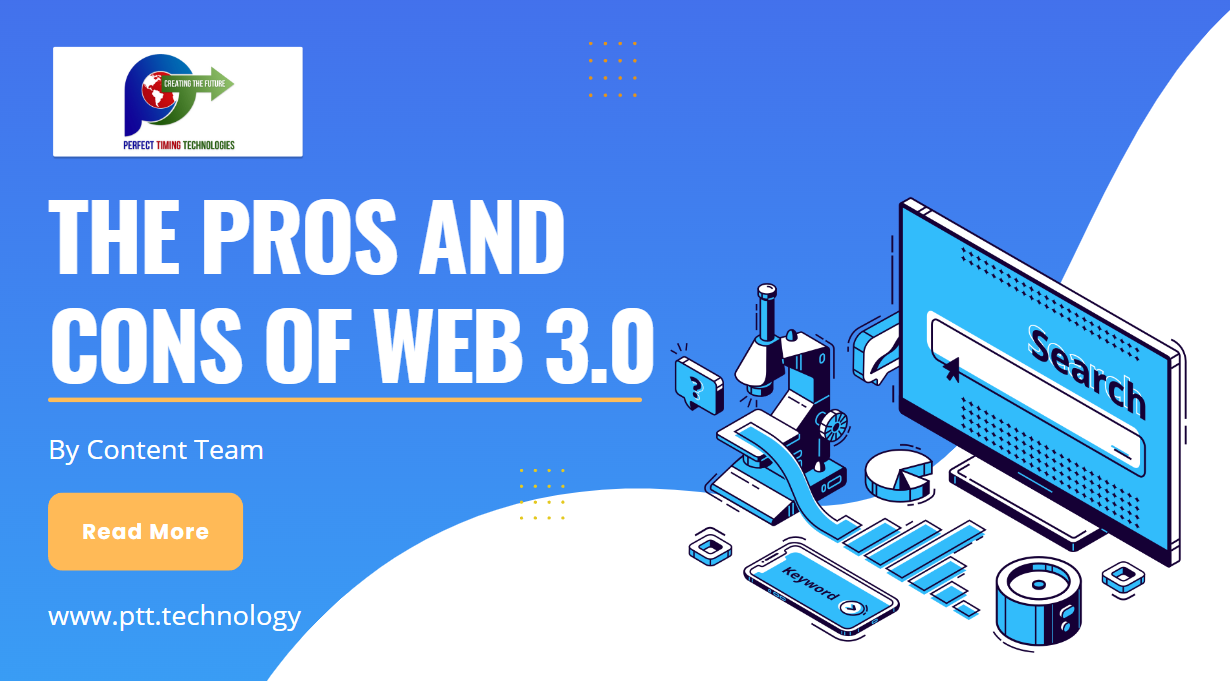
The World Wide Web has drastically evolved since its invention in 1989. The first generation web, Web 1.0, marked the modern digital economy. A decade later followed Web 2.0, highlighting interactivity and introducing more dynamic elements.
Web 3.0 is the third generation of the world wide web with enhanced technological elements embedded into it.
In the previous article, we learned about the emergence of Web 3.0 and its features. In this article, we shall move ahead with the pros and cons of Web 3.0
The Pros
Given below are some potential advantages of Web 3.0.
- Decentralized: Web 3.0 is decentralized, allowing data and services to be free from control by any single entity. It leads to data transparency, user empowerment, and reduced dependence on centralized intermediaries.
- Enhanced Privacy and Security: Web 3.0 ensures user privacy and security through cryptographic protocols, decentralized authentication, and data encryption. It helps protect user data from unauthorized access, breaches, and abuse, giving users more control over their personal information.
- Seamless Interactivity: Web 3.0 seeks to enable seamless interoperability between different web platforms, applications, and data sources. It makes sharing and exchanging data easier, transferring services and assets across various platforms and ecosystems, and leads to increased efficiency, innovation, and collaboration.
- Trust and Authenticity: Web 3.0 establishes trust and authenticity through decentralized identity systems, digital signatures, and verifiable credentials. It reduces online fraud, fake news, and misinformation, and enables more reliable online transactions and interactions.
- AI and Automation: Web 3.0 leverages artificial intelligence (AI) and automation to enable more intelligent and autonomous web applications. It results in personalized and context-aware services, enhanced search capabilities, and improved decision-making based on data-driven insights.
- User Empowerment: Web 3.0 empower users by giving them more ownership and control over their digital assets, data, and online experiences. It offers a more user-centric web where users have more agency and autonomy to interact with online services and platforms as they want.
- Innovation and Creativity: Web 3.0 has the potential to foster innovation and creativity through open protocols, decentralized governance, and incentive mechanisms, such as blockchain-based smart contracts. It creates new opportunities for developers, entrepreneurs, and content creators to build and monetize decentralized applications (dApps) and services.
The Cons
While Web 3.0 has the potential to bring significant advantages, it also presents some potential challenges and disadvantages:
- Technical Complexity: Web 3.0 technologies, such as blockchain, decentralized protocols, and cryptographic mechanisms, can be complex to understand and implement. It may act as a barrier to entry for some developers, users, and organizations, limiting widespread adoption and use.
- Scalability and Performance: Web 3.0 technologies, particularly blockchain, may face scalability and performance issues due to the distributed nature of data storage and processing. It results in slower transaction times, higher costs, and limitations in handling large-scale applications or services.
- Regulatory and Legal Concerns: The decentralized nature of Web 3.0 can present regulatory and legal challenges, as it may be difficult to establish clear jurisdiction, accountability, and compliance frameworks. It may raise concerns about data privacy, intellectual property rights, and fraud prevention, requiring new legal and regulatory approaches.
- Lack of Standardization: Web 3.0 is still an evolving concept so there is a lack of standardized protocols, frameworks, and interoperability standards. It causes fragmentation, incompatibility, and difficulties integrating different Web 3.0 technologies and platforms, hindering seamless data exchange and interoperability.
- Security Risks: While Web 3.0 aims to enhance security through cryptographic protocols, it is not immune to security risks. Smart contracts, for example, can have vulnerabilities that may be exploited, resulting in financial losses or other security breaches. Moreover, the decentralized nature of Web 3.0 can make it challenging to handle issues such as identity theft or data breaches.
- User Experience Challenges: Web 3.0 technologies may require users to manage their private keys, digital wallets, and other cryptographic tools, which can be complex and cumbersome for non-technical users. It may result in a less user-friendly experience than traditional web applications, potentially limiting mainstream adoption.
- Transition Challenges: Transitioning from the current Web 2.0 paradigm to Web 3.0 may require significant changes in technology infrastructure, business models, and user behaviors. It makes adoption, migration, and adaptation challenging and may require time and effort to realize the potential of Web 3.0.
Final Thoughts
Web 3.0 is still an emerging concept, so its challenges can be overcome with further development, standardization, and innovation. However, it’s crucial to be mindful of the potential disadvantages as technology continues to evolve.







